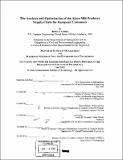| dc.contributor.advisor | Stephen C. Graves and James Masters. | en_US |
| dc.contributor.author | Urkiel, Brian A. (Brian Alexander), 1971- | en_US |
| dc.contributor.other | Leaders for Manufacturing Program. | en_US |
| dc.date.accessioned | 2006-11-08T16:21:40Z | |
| dc.date.available | 2006-11-08T16:21:40Z | |
| dc.date.copyright | 2000 | en_US |
| dc.date.issued | 2000 | en_US |
| dc.identifier.uri | http://theses.mit.edu/Dienst/UI/2.0/Describe/0018.mit.theses%2f2000-114 | en_US |
| dc.identifier.uri | http://hdl.handle.net/1721.1/34702 | |
| dc.description | Thesis (S.M.)--Massachusetts Institute of Technology, Sloan School of Management; and, (S.M.)--Massachusetts Institute of Technology, Dept. of Civil and Environmental Engineering; in conjunction with the Leaders for Manufacturing Program, Massachusetts Institute of Technology, 2000. | en_US |
| dc.description | Also available online at the MIT Theses Online homepage <http://thesis.mit.edu>. | en_US |
| dc.description | Includes bibliographical references (p. 100-101). | en_US |
| dc.description.abstract | This thesis examines the challenges of managing a global supply chain in a large, well-established organization and outlines certain techniques that can be utilized to achieve more effective supply chain management. The research was conducted at Davenport Works, which is part of the Alcoa Mill Products (AMP) Business Unit, and examined the business unit's global supply chain with its European customers. The presence of inventory can hide many of the root cause problems within a supply chain and the project driver for this work was clearly inventory reduction. However, while excessive inventory is clearly a problem and organizations should strive to reduce unnecessary inventory as much as possible, there is an optimal amount of inventory that should be maintained and that amount is rarely zero. Inventory is held for a variety of reasons and can be utilized as a tool to countermeasure the primary factors that influence inventory requirements: customer demand, demand variability, production yield, production yield variability, lead time, lead time variability, and desired customer service levels. Alcoa utilizes inventory as a countermeasure within their supply chain for a variety of reasons. Customers are demanding increasing levels of service; and their demand patterns are variable. Replenishment lead times are long (on the order of months) and variable. Davenport Works is striving to achieve economies of scale; and their production yields are variable and often times deviate significantly from the customer's forecasted consumption rate. Currently, high levels of inventory are being maintained throughout the supply chain; and desired customer service level targets are not being met. AMP has no formal methodologies to both characterize the reasons why inventory is being maintained and to determine what inventory requirements they need to satisfy each specific customer program. In addition, AMP is driving cost reductions throughout the entire organization. This is forcing the organization to justify the inventory they currently have and also putting pressure on the organization to reduce inventories throughout the supply chain. This thesis has three primary objectives. Firstly, to provide a detailed analysis of the entire AMP supply chain for its European customers and articulate the reasons why AMP is maintaining inventory. This includes a discussion about supply chains, supply chain management, and the role of inventory in the supply chain. Secondly, to describe a methodology, which can be applied to engineer inventory levels for each product. The base stock model was used for this and is an excellent tool to demonstrate how supply chain variables impact inventory requirements, target areas for improvement, and quantify inventory requirements in a systematic manner. Thirdly, to provide recommendations to improve overall supply chain performance and optimize inventories. | en_US |
| dc.description.statementofresponsibility | by Brian A. Urkiel. | en_US |
| dc.format.extent | 107 p. | en_US |
| dc.format.extent | 11819912 bytes | |
| dc.format.extent | 11819670 bytes | |
| dc.format.mimetype | application/pdf | |
| dc.format.mimetype | application/pdf | |
| dc.language.iso | eng | en_US |
| dc.publisher | Massachusetts Institute of Technology | en_US |
| dc.rights | M.I.T. theses are protected by copyright. They may be viewed from this source for any purpose, but reproduction or distribution in any format is prohibited without written permission. See provided URL for inquiries about permission. | en_US |
| dc.rights.uri | http://theses.mit.edu/Dienst/UI/2.0/Describe/0018.mit.theses%2f2000-114 | en_US |
| dc.rights.uri | http://dspace.mit.edu/handle/1721.1/7582 | |
| dc.subject | Sloan School of Management. | en_US |
| dc.subject | Civil and Environmental Engineering. | en_US |
| dc.subject | Leaders for Manufacturing Program. | en_US |
| dc.title | The analysis and optimization of the Alcoa Mill Products supply chain for European customers | en_US |
| dc.title.alternative | Analysis and optimization of the AMP supply chain for European customers | en_US |
| dc.type | Thesis | en_US |
| dc.description.degree | S.M. | en_US |
| dc.contributor.department | Leaders for Manufacturing Program at MIT | en_US |
| dc.contributor.department | Massachusetts Institute of Technology. Department of Civil and Environmental Engineering | |
| dc.contributor.department | Sloan School of Management | |
| dc.identifier.oclc | 45502590 | en_US |
